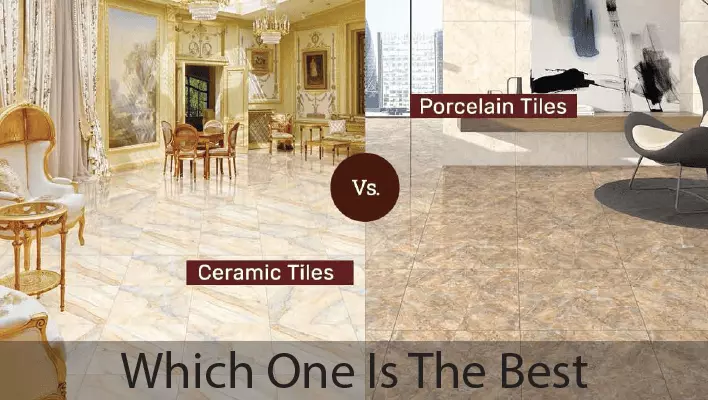Ceramics and porcelain are used in construction work and pottery; the main difference between procelain and ceramic is, as these materials have their own properties, benefits, and uses. The reason why they are used in construction work is their beauty as they can make items more attractive. Mostly, they are used in tiles and other industrial items, but people think they are only used in tiles.
Ceramic and porcelain tiles are the most famous types used in construction work, including homes, offices, schools, commercial buildings, and many other places. The interesting thing about ceramic and porcelain is that they are made from the same material called clay.
But their manufacturing process is different; the ceramic is made by heating and solidifying the clay. On the other hand, the porcelain is also made from clay, but at a higher temperature; you will be surprised to know that 2600 degree Fahrenheit temperature is required to make the porcelain.
You need to understand that ceramic and porcelain do not have a very big difference; we can also say that they are from the same family and are cousins. People only know about ceramic and porcelain tiles so you can use the tiles according to your project. Before installing or sealing your walls with tiles, you need to understand what type of tiles should be best for your project or space.
Also Read: Can You Use Porcelain Tiles in a Shower?
Content
Major Difference Between Porcelain and Ceramic Tiles

We have discussed that ceramic and porcelain are from the same family, but still, there are many differences between them. Here is a little bit of a comparison between these two materials.
- The main difference between ceramic and porcelain is that porcelain is translucent, and ceramic is opaque. The porcelain is fine and smooth like an eggshell if we discuss its smoothness.
- Porcelain is thin compared to ceramic, which is why porcelain tiles are thinner than ceramic tiles. Now, if we discuss the color, the porcelain has a white color; the interesting thing about porcelain that distinguishes it from ceramic is that it is denser and less prone to moisture.
- Porcelain tiles are expensive compared to ceramic, and the simple reason is their moisture quality. The porcelain tiles are non-porous, so their chances of cracking in the cold season are zero; on the other hand, the ceramic material is porous, and that’s why the moisture problem can be faced if you seal your walls with ceramic tiles.
History
The word porcelain is derived from the Italian word Porcelland, which means translucent surface. On the other hand, the term ceramic is derived from the Greek word Kiramikos which means pottery.
Appearance Features
The ceramic and porcelain tiles are famous constructional items used while developing buildings and roads. We will discuss the appearance of the ceramic and porcelain tiles.
Ceramic Tiles
The ceramic tiles have solid color and pattern, which is why you cannot make a copy of ceramic materials. The simulation of natural stone or wood grains is not common with ceramic tile. The ceramic is hard to mix with other materials because of its solidity and regular patterns.
Porcelain Tiles
An important thing that makes the construction companies resemble porcelain with other materials using pottery things, like cups. The porcelain material can also be mixed with natural stone to make some other products, like marble. This is why porcelain tiles are considered the best option in water-using locations like kitchens and bathrooms.
If we recommend tile according to its appearance, then porcelain is always the best; it has very smooth edges, available in different colors and furnishes.
Water and Heat Resistance Features
Both ceramic and porcelain show good heat resistance, and even in many locations, these tiles are used on countertops.
Ceramic Tiles
The ceramic tile is considered the more susceptible to moisture, but if the tile is glazed, it shows strong resistance against water. So you don’t need to worry till your tile is glazed; the unglazed portion of the tile will don’t show any water resistance. On the other hand, the ceramic shows good resistance to heat; that’s why they can be easily used on countertops.
Porcelain Tiles
The porcelain tile is heavier, denser, and impervious to water. The porcelain shows more heat resistance than the ceramic, which is why ceramic is recommended for indoor locations. Porcelain is the best for countertops because it is heat resistant and can last long without damage.
Care and Cleaning Features
These tiles have the same instructions for cleaning, the porcelain tile is easy to care for and clean, and you can easily clean it using a soap solution. An important thing you must keep in mind while installing the tiles is to fill the gap between them with good material; otherwise, you can face problems while cleaning.
The ceramic tiles can also be cleaned using soap, so this section has not made a very big difference.
FAQs
Also Read: How To Clean Bathroom Tiles?
Conclusion
Ceramics and porcelain are famous constructional materials; they are mostly used in tiles and are known as ceramic and porcelain tiles. You can install these tiles on the walls of your home building, offices, and schools according to your interest and budget.























